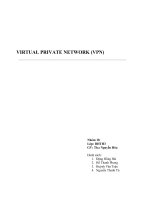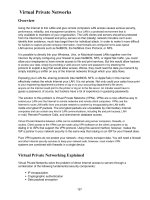VIRTUAL PRIVATE NETWORKS (VPN) docx
Bạn đang xem bản rút gọn của tài liệu. Xem và tải ngay bản đầy đủ của tài liệu tại đây (472.33 KB, 38 trang )
VIRTUAL PRIVATE
VIRTUAL PRIVATE
NETWORKS (VPN)
NETWORKS (VPN)
BY:
BY:
Diana Ashikyan
Diana Ashikyan
Nikhil Jerath
Nikhil Jerath
Connie Makalintal
Connie Makalintal
Midori Murata
Midori Murata
Traditional Connectivity
Traditional Connectivity
[From Gartner Consulting]
[From Gartner Consulting]
What is VPN?
What is VPN?
Virtual Private Network is a type of private
Virtual Private Network is a type of private
network that uses public telecommunication,
network that uses public telecommunication,
such as the Internet, instead of leased lines to
such as the Internet, instead of leased lines to
communicate.
communicate.
Became popular as more employees worked in
Became popular as more employees worked in
remote locations.
remote locations.
Terminologies to understand how VPNs work.
Terminologies to understand how VPNs work.
Private Networks
Private Networks
vs.
vs.
Virtual Private Networks
Virtual Private Networks
Employees can access the network (Intranet) from
Employees can access the network (Intranet) from
remote locations.
remote locations.
Secured networks.
Secured networks.
The Internet is used as the backbone for VPNs
The Internet is used as the backbone for VPNs
Saves cost tremendously from reduction of equipment
Saves cost tremendously from reduction of equipment
and maintenance costs.
and maintenance costs.
Scalability
Scalability
Remote Access Virtual Private
Remote Access Virtual Private
Network
Network
(From Gartner Consulting)
Brief Overview of How it Works
Brief Overview of How it Works
Two connections – one is made to the Internet
Two connections – one is made to the Internet
and the second is made to the VPN.
and the second is made to the VPN.
Datagrams – contains data, destination and
Datagrams – contains data, destination and
source information.
source information.
Firewalls – VPNs allow authorized users to pass
Firewalls – VPNs allow authorized users to pass
through the firewalls.
through the firewalls.
Protocols – protocols create the VPN tunnels.
Protocols – protocols create the VPN tunnels.
Four Critical Functions
Four Critical Functions
Authentication
Authentication
– validates that the data was sent
– validates that the data was sent
from the sender.
from the sender.
Access control
Access control
– limiting unauthorized users from
– limiting unauthorized users from
accessing the network.
accessing the network.
Confidentiality
Confidentiality
– preventing the data to be read or
– preventing the data to be read or
copied as the data is being transported.
copied as the data is being transported.
Data Integrity
Data Integrity
– ensuring that the data has not been
– ensuring that the data has not been
altered
altered
Encryption
Encryption
Encryption is a method of “scrambling” data
Encryption is a method of “scrambling” data
before transmitting it onto the Internet.
before transmitting it onto the Internet.
Public Key Encryption Technique
Public Key Encryption Technique
Digital signature – for authentication
Digital signature – for authentication
Tunneling
Tunneling
A virtual point-to-point connection
A virtual point-to-point connection
made through a public network. It transports
made through a public network. It transports
encapsulated datagrams.
encapsulated datagrams.
Encrypted Inner Datagram
Datagram Header Outer Datagram Data Area
Original Datagram
Data Encapsulation [From Comer]
Two types of end points:
Remote Access
Site-to-Site
Four Protocols used in VPN
Four Protocols used in VPN
PPTP Point-to-Point Tunneling Protocol
PPTP Point-to-Point Tunneling Protocol
L2TP Layer 2 Tunneling Protocol
L2TP Layer 2 Tunneling Protocol
IPsec Internet Protocol Security
IPsec Internet Protocol Security
SOCKS – is not used as much as the ones
SOCKS – is not used as much as the ones
above
above
VPN Encapsulation of Packets
VPN Encapsulation of Packets
Types of Implementations
Types of Implementations
What does “implementation” mean in VPNs?
What does “implementation” mean in VPNs?
3 types
3 types
Intranet – Within an organization
Intranet – Within an organization
Extranet – Outside an organization
Extranet – Outside an organization
Remote Access – Employee to Business
Remote Access – Employee to Business
Virtual Private Networks (VPN)
Basic Architecture
Device Types
Device Types
What it means
What it means
3 types
3 types
Hardware
Hardware
Firewall
Firewall
Software
Software
Device Types: Hardware
Device Types: Hardware
Usually a VPN type of router
Usually a VPN type of router
Pros
•
Highest network throughput
•
Plug and Play
•
Dual-purpose
Cons
•
Cost
•
Lack of flexibility
Device Types: Firewall
Device Types: Firewall
More security?
More security?
Pros
•
“Harden” Operating System
•
Tri-purpose
•
Cost-effective
Cons
•
Still relatively costly
Device Types: Software
Device Types: Software
Ideal for 2 end points not in same org.
Ideal for 2 end points not in same org.
Great when different firewalls implemented
Great when different firewalls implemented
Pros
•
Flexible
•
Low relative cost
Cons
•
Lack of efficiency
•
More labor
training required
•
Lower
productivity; higher
labor costs
Advantages
Advantages
VS.
VS.
Disadvantages
Disadvantages
Eliminating the need for expensive long-distance
Eliminating the need for expensive long-distance
leased lines
leased lines
Reducing the long-distance telephone charges
Reducing the long-distance telephone charges
for remote access.
for remote access.
Transferring the support burden to the service
Transferring the support burden to the service
providers
providers
Operational costs
Operational costs
Cisco VPN Savings Calculator
Cisco VPN Savings Calculator
Advantages: Cost Savings
Advantages: Cost Savings
Flexibility of growth
Flexibility of growth
Efficiency with broadband technology
Efficiency with broadband technology
Advantages: Scalability
Advantages: Scalability
VPNs require an in-depth understanding of
VPNs require an in-depth understanding of
public network security issues and proper
public network security issues and proper
deployment of precautions
deployment of precautions
Availability and performance depends on factors
Availability and performance depends on factors
largely outside of their control
largely outside of their control
Immature standards
Immature standards
VPNs need to accommodate protocols other
VPNs need to accommodate protocols other
than IP and existing internal network technology
than IP and existing internal network technology
Disadvantages
Disadvantages
Applications: Site-to-Site VPNs
Applications: Site-to-Site VPNs
Large-scale encryption between multiple fixed
Large-scale encryption between multiple fixed
sites such as remote offices and central offices
sites such as remote offices and central offices
Network traffic is sent over the branch office
Network traffic is sent over the branch office
Internet connection
Internet connection
This saves the company hardware and
This saves the company hardware and
management expenses
management expenses
Site-to-Site VPNs
Site-to-Site VPNs
Applications: Remote Access
Applications: Remote Access
Encrypted connections between mobile or
Encrypted connections between mobile or
remote users and their corporate networks
remote users and their corporate networks
Remote user can make a local call to an ISP, as
Remote user can make a local call to an ISP, as
opposed to a long distance call to the corporate
opposed to a long distance call to the corporate
remote access server.
remote access server.
Ideal for a telecommuter or mobile sales people.
Ideal for a telecommuter or mobile sales people.
VPN allows mobile workers & telecommuters to
VPN allows mobile workers & telecommuters to
take advantage of broadband connectivity.
take advantage of broadband connectivity.
i.e. DSL, Cable
i.e. DSL, Cable
Industries That May Use a VPN
Industries That May Use a VPN
Healthcare:
Healthcare:
enables the transferring of confidential patient information within
enables the transferring of confidential patient information within
the medical facilities & health care provider
the medical facilities & health care provider
Manufacturing
Manufacturing
: allow suppliers to view inventory & allow clients to purchase
: allow suppliers to view inventory & allow clients to purchase
online safely
online safely
Retail:
Retail:
able to securely transfer sales data or customer info between stores &
able to securely transfer sales data or customer info between stores &
the headquarters
the headquarters
Banking/Financial:
Banking/Financial:
enables account information to be transferred safely within
enables account information to be transferred safely within
departments & branches
departments & branches
General Business:
General Business:
communication between remote employees can be
communication between remote employees can be
securely exchanged
securely exchanged









